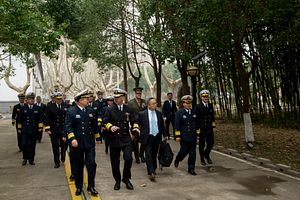The U.S. Chief of Naval Operations, Admiral John Richardson, met his Chinese counterpart, PLA Navy Commander Vice Admiral Shen Jinlong, for a professional dialogue in Beijing on January 14th. A U.S. Navy release said the talks focused on encouraging professional interactions between the two navies at sea through operational safety and risk reduction measures with the aim of preventing unwanted and unnecessary escalation.
Admiral Richardson will be in China for three days, meeting with senior Chinese defense leadership, visiting the PLA Navy’s headquarters and Research Academy, and concluding with a roundtable at the PLA Navy’s Command College in Nanjing. In addition to engagements with Chinese leadership, he also met with defense attaches from 18 partner and ally nations posted in Beijing.
The two admirals met once before at an international naval symposium at the U.S. Naval War College in 2018 and have spoken via video-conference three times since he became head of the PLA Navy in 2017, most recently in December. Admiral Shen’s attendance at the 2018 symposium was cut short when he was recalled to Beijing as part of China’s response to the United States’ sanctioning of Central Military Commission officials over the purchase of Russian military equipment.
Ahead of the trip, Admiral Richardson said that “A routine exchange of views is essential, especially in times of friction, in order to reduce risk and avoid miscalculation. Honest and frank dialogue can improve the relationship in constructive ways, help explore areas where we share common interests, and reduce risk while we work through our differences.”
The two countries’ ships and aircraft are often in contact in the East and South China Seas. China objects to U.S. surveillance flights near its coast and U.S. ships operating in proximity to claimed territory, where it asserts that foreign warships can only operate with Chinese permission. Chinese fighter jets often intercept U.S. surveillance aircraft and have occasionally conducted unsafe or unprofessional maneuvers around them.
Interactions between U.S. and Chinese warships have rarely been as fraught as these aircraft incidents, but last September a Chinese destroyer maneuvered aggressively around a U.S. destroyer conducting a Freedom of Navigation operation in the South China Sea. The Chinese warship cut across the U.S. ship’s bow at 45 yards, risking a collision.
Despite China and the U.S. concluding memorandums of understanding to guide safe operations between their ships and aircraft in 2014 and 2015, CNN reported last fall that there have been 18 unsafe encounters between U.S. and Chinese military units since 2016.
From the U.S. Navy’s perspective, those incidents highlight the importance of keeping up a dialogue with the PLA Navy. Admiral Richardson said that “These meetings between senior leaders allow us to speak candidly about areas where we agree and about how to manage risk while we resolve our differences.”
However, there are practical limits to the ability of the two navies to resolve differences or prevent incidents on their own. The U.S Navy does not conduct surveillance flights or Freedom of Navigation Operations unilaterally, it does so in fulfillment of policies and decisions made by civilian political leadership. Similarly, the PLA Navy acts within bounds set by its political leaders in the Central Military Commission.
The navies have the most discretion in how their ships and aircraft act to defend themselves against hostile acts. If talks at the military level lead to understandings that reduce ambiguity around interactions between their ships and aircraft, it reduces the risk that an act might be misinterpreted as hostile or threatening when that isn’t the other country’s intention.

































